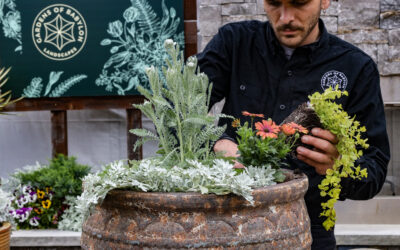——————————————————————–
Watering is one of the essential components needed to keep a landscape alive and thriving. But how much water is enough? Is there such a thing as too much?
How Much Water Do Plants Really Need?
There’s no one-size-fits-all answer to this basic question. Experts at the University of Tennessee Extension remind us that moisture needs differ based on plant species, season, and the environment, along with whether the gardener’s goal is to achieve optimum growth and performance, or merely to ensure survival.
For example, established perennial beds in loamy soil may be fine with an occasional dry spell, especially if the gardener has supplied mulch; that tomato patch, however, is likely to produce cracked, diseased fruit if watering is inconsistent. And plants in sandy soil, which drains more quickly, may need more attention.
Too much water, though, can produce its own set of problems. Clay soil, which doesn’t drain well, can be a cause of damaged or rotting roots. Plants in waterlogged soil may drown due to lack of oxygen. Overhead watering at the wrong time of day can result in fungal diseases (morning watering is best so that plants’ foliage dries before nightfall). Compacted soil can mean the water that does fall (or drip or sprinkle) runs off and doesn’t reach the roots.
Irrigation Guidelines
UT Extension provides general guidelines for specific types of landscape plants – recognizing, still, that needs vary based on species, environmental conditions and age of the plants. Note, too: A rain gauge, which helps keep up with how much “natural” irrigation occurs and when supplemental irrigation is necessary, could be considered an essential tool:
Lawns: The general rule for grass is 1 inch of water per week, but remember that this may depend on the species of grass, condition of the soil and age of the lawn. For grass with deeper roots, experts suggest watering deeper, but less frequently, as shorter watering every day encourages shallow root growth.
Perennial beds: Water newly planted perennials deeply to encourage deep root growth while they are establishing themselves in the beds. After they’re established, many native and adapted species may not require regular watering under normal conditions. During periods when rainfall is scant or nonexistent, even well-established plants may need supplemental irrigation.
Vegetables and annuals: These are notoriously thirsty plants, but still may not need daily watering. UT Extension suggests watering when the top 4 to 6 inches of soil is no longer moist, or 3 to 6 inches when plants are new and establishing roots. Keep an eye on the amount of rain the garden gets, and gauge your garden’s needs for supplemental watering. And use mulch to maintain more consistent moisture in the soil.
Containers: Soil in containers dries out quickly, and it’s worth checking every day during the hottest part of summer to see if the soil in your porch or patio plants needs moisture.
Irrigation Systems
Hauling hoses and sprinklers around the yard and garden beds can be a chore, especially in mid-summer heat. An in-ground irrigation system can be an appealing option, says Tim Nebel, Gardens of Babylon’s landscape production manager.
“The biggest advantage, if you have a system set up correctly and a good watering schedule, is that the system is taking care of watering needs for you,” Nebel says. And when systems can be programmed to provide water as needed and adjusted to meet different needs throughout the season, it can save money.
Different types of nozzles in a system provide different functions. Rotors are generally used for turf areas, Nebel explains. Fixed spray heads cover smaller lawns or garden beds, and drip irrigation can be set up to focus on plants’ root zones. This can help assure that specific areas get enough – but not too much – water for gardens and lawns to thrive throughout the seasons.
And like many other home accoutrements, irrigation systems can be “smart.” “Smart controllers run through wi-fi through an app on the phone,” Nebel explains. “You can run it from anywhere through remote control. Smart systems (such as Hunter Industries’ system Hydrawise) can adjust watering based on local weather data – if it’s raining when the system is programmed to run, it doesn’t turn itself on.
An advantage of setting up a regular schedule on any system is that it’s worry-free, Nebel says. “You set it up and don’ have to think about it except to make sure it’s in auto-run position.”
*
Gardens of Babylon installs and maintains irrigation systems, and offers different maintenance package levels for landscapes of all sizes. Click here to learn more about the systems and book a consultation with the Landscape Design team.






0 Comments